Lucene之MinShouldMatchScorer算法源码分析
2013-10-11 17:30
176 查看
在lucene中检索出来的文档用倒排列表来表示,每个query Term对应一个倒排列表。每个列表的长度则
表示有多少篇文档含有该Term。那么在Lucene中大部分的查询都是Boolean查询(AND,OR,NOT),对于AND
来说,直接对倒排列表求交集就可以了,由于倒排列表采用跳跃表结构,所以求交比较快,具体过程参见大
牛觉先的blog(http://www.cnblogs.com/forfuture1978/archive/2010/04/04/1704258.html),但是对于
OR操作来说则是求并集,原先的DisjunctionSumScorer中有成员变量List<Scorer> subScorers,是一个Scorer
的链表,每一项代表一个倒排表,DisjunctionSumScorer就是对这些倒排表取并集,然后将并集中的文档号在nextDoc()函数中依次返回。DisjunctionSumScorer有一个成员变量minimumNrMatchers,表示最少需满足的子
条件的个数,也即subScorer中,必须有至少minimumNrMatchers个Scorer都包含某个文档号,此文档号才能够
返回,具体流程如下(转自觉先blog:http://write.blog.csdn.net/postedit/12614525)
(1) 假设minimumNrMatchers = 4,倒排表最初如下:
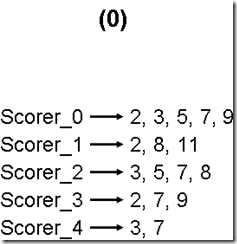
(2) 在DisjunctionSumScorer的构造函数中,将倒排表放入一个优先级队列scorerDocQueue中(scorerDocQueue的实现是一个最小堆),队列中的Scorer按照第一篇文档的大小排序。

(3) 当BooleanScorer2.score(Collector)中第一次调用nextDoc()的时候,advanceAfterCurrent被调用。
advanceAfterCurrent具体过程如下:
最初,currentDoc=2,文档2的nrMatchers=1

最顶层的Scorer 0取得下一篇文档,为文档3,重新调整最小堆后如下图。此时currentDoc等于最顶层Scorer 1的第一篇文档号,都为2,文档2的nrMatchers为2。

最顶层的Scorer 1取得下一篇文档,为文档8,重新调整最小堆后如下图。此时currentDoc等于最顶层Scorer 3的第一篇文档号,都为2,文档2的nrMatchers为3。

最顶层的Scorer 3取得下一篇文档,为文档7,重新调整最小堆后如下图。此时currentDoc还为2,不等于最顶层Scorer 2的第一篇文档3,于是退出内循环。此时检查,发现文档2的nrMatchers为3,小于minimumNrMatchers,不满足条件。于是currentDoc设为最顶层Scorer 2的第一篇文档3,nrMatchers设为1,重新进入下一轮循环。

最顶层的Scorer 2取得下一篇文档,为文档5,重新调整最小堆后如下图。此时currentDoc等于最顶层Scorer 4的第一篇文档号,都为3,文档3的nrMatchers为2。
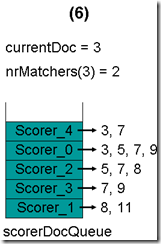
最顶层的Scorer 4取得下一篇文档,为文档7,重新调整最小堆后如下图。此时currentDoc等于最顶层Scorer 0的第一篇文档号,都为3,文档3的nrMatchers为3。
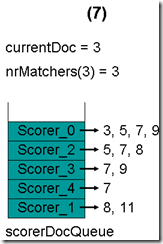
最顶层的Scorer 0取得下一篇文档,为文档5,重新调整最小堆后如下图。此时currentDoc还为3,不等于最顶层Scorer 0的第一篇文档5,于是退出内循环。此时检查,发现文档3的nrMatchers为3,小于minimumNrMatchers,不满足条件。于是currentDoc设为最顶层Scorer 0的第一篇文档5,nrMatchers设为1,重新进入下一轮循环。
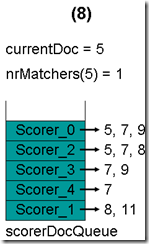
最顶层的Scorer 0取得下一篇文档,为文档7,重新调整最小堆后如下图。此时currentDoc等于最顶层Scorer 2的第一篇文档号,都为5,文档5的nrMatchers为2。

最顶层的Scorer 2取得下一篇文档,为文档7,重新调整最小堆后如下图。此时currentDoc还为5,不等于最顶层Scorer 2的第一篇文档7,于是退出内循环。此时检查,发现文档5的nrMatchers为2,小于minimumNrMatchers,不满足条件。于是currentDoc设为最顶层Scorer 2的第一篇文档7,nrMatchers设为1,重新进入下一轮循环。
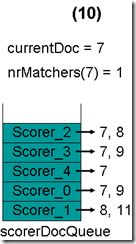
最顶层的Scorer 2取得下一篇文档,为文档8,重新调整最小堆后如下图。此时currentDoc等于最顶层Scorer 3的第一篇文档号,都为7,文档7的nrMatchers为2。
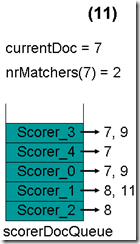
最顶层的Scorer 3取得下一篇文档,为文档9,重新调整最小堆后如下图。此时currentDoc等于最顶层Scorer 4的第一篇文档号,都为7,文档7的nrMatchers为3。
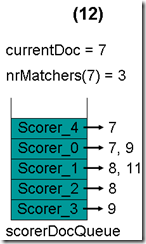
最顶层的Scorer 4取得下一篇文档,结果为空,Scorer 4所有的文档遍历完毕,弹出队列,重新调整最小堆后如下图。此时currentDoc等于最顶层Scorer 0的第一篇文档号,都为7,文档7的nrMatchers为4。
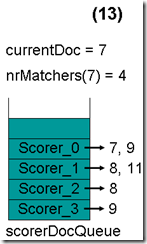
最顶层的Scorer 0取得下一篇文档,为文档9,重新调整最小堆后如下图。此时currentDoc还为7,不等于最顶层Scorer 1的第一篇文档8,于是退出内循环。此时检查,发现文档7的nrMatchers为4,大于等于minimumNrMatchers,满足条件,返回true,退出外循环。
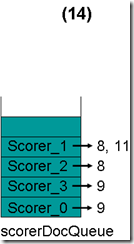
(4) currentDoc设为7,在收集文档的过程中,DisjunctionSumScorer.docID()会被调用,返回currentDoc,也即当前的文档号为7。
(5) 当再次调用nextDoc()的时候,文档8, 9, 11都不满足要求,最后返回NO_MORE_DOCS,倒排表合并结束。
以上分析过程转自觉先blog
但是这样就需要一次pop出每个docid来进行判断。效率比较慢。
Stefan Pohl 认为现在的跳跃表已经使ConjunctionScorer(交集)很高效了,那么能不能在利用MinShouldMatch这个条件在DisjunctionSumScorer(并集)中最大化求交集呐?他的做法是先从subScorers
list中取出MinShouldMatch-1个scorer存入一个数组mmstack中,剩下的存入heap,首先从heap中获取候选的docid,count heap中当前匹配的docid个数,然后再拿这个docid和数组mmstack中的每个scorer的倒排列表进行求交,计算MinShouldMatch是否满足要求。
具体实现参加以下关键源码(源文件在lucene发布的4.3.0版本中org.apache.lucene.search.MinShouldMatchSumScorer.java):
1、首先对subScorers进行按cost()值降序排序,关于cost() 函数的意思,4.3.0API解释:
2、如何最大化进行求交集的数组呐?对subScorers排序之后把倒排列表最长的mm-1个Scorer存入了mmStack中,这样就大大减少了Heap中pop操作和比较的次数.那么有个问题就是为什么是mm-1,为什么不是mm个呐??这个问题很好解释。因为我们首先从heap获取候选集,然后再和mmStack求交。一种比较坏的情况是如果把mmStack数组长度设置成mm(也就是MinShouldMatch的值),那么就很有可能一些符合条件的docid全部落在了mmStack中。那么这样你再先从heap中获取候选docid,然后在和mmStack求交就没有结果了。所以最大化的mmStack长度为minShoudlMatch
- 1.
3、再和mmStack求交时,对mmStack中Scorer是从短到长遍历,好处是,一旦剩下的Scorer数+当前minShoudlMatch 小于给定条件的话就跳出了,不用再比较剩下list较长的Scorer了。
具体的讨论过程和性能测试参见:
https://issues.apache.org/jira/browse/LUCENE-4571
表示有多少篇文档含有该Term。那么在Lucene中大部分的查询都是Boolean查询(AND,OR,NOT),对于AND
来说,直接对倒排列表求交集就可以了,由于倒排列表采用跳跃表结构,所以求交比较快,具体过程参见大
牛觉先的blog(http://www.cnblogs.com/forfuture1978/archive/2010/04/04/1704258.html),但是对于
OR操作来说则是求并集,原先的DisjunctionSumScorer中有成员变量List<Scorer> subScorers,是一个Scorer
的链表,每一项代表一个倒排表,DisjunctionSumScorer就是对这些倒排表取并集,然后将并集中的文档号在nextDoc()函数中依次返回。DisjunctionSumScorer有一个成员变量minimumNrMatchers,表示最少需满足的子
条件的个数,也即subScorer中,必须有至少minimumNrMatchers个Scorer都包含某个文档号,此文档号才能够
返回,具体流程如下(转自觉先blog:http://write.blog.csdn.net/postedit/12614525)
(1) 假设minimumNrMatchers = 4,倒排表最初如下:

(2) 在DisjunctionSumScorer的构造函数中,将倒排表放入一个优先级队列scorerDocQueue中(scorerDocQueue的实现是一个最小堆),队列中的Scorer按照第一篇文档的大小排序。
| private void initScorerDocQueue() throws IOException { scorerDocQueue = new ScorerDocQueue(nrScorers); for (Scorer se : subScorers) { if (se.nextDoc() != NO_MORE_DOCS) { //此处的nextDoc使得每个Scorer得到第一篇文档号。 scorerDocQueue.insert(se); } } } |

(3) 当BooleanScorer2.score(Collector)中第一次调用nextDoc()的时候,advanceAfterCurrent被调用。
| public int nextDoc() throws IOException { if (scorerDocQueue.size() < minimumNrMatchers || !advanceAfterCurrent()) { currentDoc = NO_MORE_DOCS; } return currentDoc; } |
| protected boolean advanceAfterCurrent() throws IOException { do { currentDoc = scorerDocQueue.topDoc(); //当前的文档号为最顶层 currentScore = scorerDocQueue.topScore(); //当前文档的打分 nrMatchers = 1; //当前文档满足的子条件的个数,也即包含当前文档号的Scorer的个数 do { //所谓topNextAndAdjustElsePop是指,最顶层(top)的Scorer取下一篇文档(Next),如果能够取到,则最小堆的堆顶可能不再是最小值了,需要调整(Adjust,其实是downHeap()),如果不能够取到,则最顶层的Scorer已经为空,则弹出队列(Pop)。 if (!scorerDocQueue.topNextAndAdjustElsePop()) { if (scorerDocQueue.size() == 0) { break; // nothing more to advance, check for last match. } } //当最顶层的Scorer取到下一篇文档,并且调整完毕后,再取出此时最上层的Scorer的第一篇文档,如果不是currentDoc,说明currentDoc此文档号已经统计完毕nrMatchers,则退出内层循环。 if (scorerDocQueue.topDoc() != currentDoc) { break; // All remaining subscorers are after currentDoc. } //否则nrMatchers加一,也即又多了一个Scorer也包含此文档号。 currentScore += scorerDocQueue.topScore(); nrMatchers++; } while (true); //如果统计出的nrMatchers大于最少需满足的子条件的个数,则此currentDoc就是满足条件的文档,则返回true,在收集文档的过程中,DisjunctionSumScorer.docID()会被调用,返回currentDoc。 if (nrMatchers >= minimumNrMatchers) { return true; } else if (scorerDocQueue.size() < minimumNrMatchers) { return false; } } while (true); } |
最初,currentDoc=2,文档2的nrMatchers=1

最顶层的Scorer 0取得下一篇文档,为文档3,重新调整最小堆后如下图。此时currentDoc等于最顶层Scorer 1的第一篇文档号,都为2,文档2的nrMatchers为2。

最顶层的Scorer 1取得下一篇文档,为文档8,重新调整最小堆后如下图。此时currentDoc等于最顶层Scorer 3的第一篇文档号,都为2,文档2的nrMatchers为3。

最顶层的Scorer 3取得下一篇文档,为文档7,重新调整最小堆后如下图。此时currentDoc还为2,不等于最顶层Scorer 2的第一篇文档3,于是退出内循环。此时检查,发现文档2的nrMatchers为3,小于minimumNrMatchers,不满足条件。于是currentDoc设为最顶层Scorer 2的第一篇文档3,nrMatchers设为1,重新进入下一轮循环。

最顶层的Scorer 2取得下一篇文档,为文档5,重新调整最小堆后如下图。此时currentDoc等于最顶层Scorer 4的第一篇文档号,都为3,文档3的nrMatchers为2。

最顶层的Scorer 4取得下一篇文档,为文档7,重新调整最小堆后如下图。此时currentDoc等于最顶层Scorer 0的第一篇文档号,都为3,文档3的nrMatchers为3。

最顶层的Scorer 0取得下一篇文档,为文档5,重新调整最小堆后如下图。此时currentDoc还为3,不等于最顶层Scorer 0的第一篇文档5,于是退出内循环。此时检查,发现文档3的nrMatchers为3,小于minimumNrMatchers,不满足条件。于是currentDoc设为最顶层Scorer 0的第一篇文档5,nrMatchers设为1,重新进入下一轮循环。

最顶层的Scorer 0取得下一篇文档,为文档7,重新调整最小堆后如下图。此时currentDoc等于最顶层Scorer 2的第一篇文档号,都为5,文档5的nrMatchers为2。

最顶层的Scorer 2取得下一篇文档,为文档7,重新调整最小堆后如下图。此时currentDoc还为5,不等于最顶层Scorer 2的第一篇文档7,于是退出内循环。此时检查,发现文档5的nrMatchers为2,小于minimumNrMatchers,不满足条件。于是currentDoc设为最顶层Scorer 2的第一篇文档7,nrMatchers设为1,重新进入下一轮循环。

最顶层的Scorer 2取得下一篇文档,为文档8,重新调整最小堆后如下图。此时currentDoc等于最顶层Scorer 3的第一篇文档号,都为7,文档7的nrMatchers为2。

最顶层的Scorer 3取得下一篇文档,为文档9,重新调整最小堆后如下图。此时currentDoc等于最顶层Scorer 4的第一篇文档号,都为7,文档7的nrMatchers为3。

最顶层的Scorer 4取得下一篇文档,结果为空,Scorer 4所有的文档遍历完毕,弹出队列,重新调整最小堆后如下图。此时currentDoc等于最顶层Scorer 0的第一篇文档号,都为7,文档7的nrMatchers为4。

最顶层的Scorer 0取得下一篇文档,为文档9,重新调整最小堆后如下图。此时currentDoc还为7,不等于最顶层Scorer 1的第一篇文档8,于是退出内循环。此时检查,发现文档7的nrMatchers为4,大于等于minimumNrMatchers,满足条件,返回true,退出外循环。

(4) currentDoc设为7,在收集文档的过程中,DisjunctionSumScorer.docID()会被调用,返回currentDoc,也即当前的文档号为7。
(5) 当再次调用nextDoc()的时候,文档8, 9, 11都不满足要求,最后返回NO_MORE_DOCS,倒排表合并结束。
以上分析过程转自觉先blog
但是这样就需要一次pop出每个docid来进行判断。效率比较慢。
Stefan Pohl 认为现在的跳跃表已经使ConjunctionScorer(交集)很高效了,那么能不能在利用MinShouldMatch这个条件在DisjunctionSumScorer(并集)中最大化求交集呐?他的做法是先从subScorers
list中取出MinShouldMatch-1个scorer存入一个数组mmstack中,剩下的存入heap,首先从heap中获取候选的docid,count heap中当前匹配的docid个数,然后再拿这个docid和数组mmstack中的每个scorer的倒排列表进行求交,计算MinShouldMatch是否满足要求。
具体实现参加以下关键源码(源文件在lucene发布的4.3.0版本中org.apache.lucene.search.MinShouldMatchSumScorer.java):
class MinShouldMatchSumScorer extends Scorer {
/** The overall number of non-finalized scorers */
private int numScorers;
/** The minimum number of scorers that should match */
private final int mm;
/** A static array of all subscorers sorted by decreasing cost */
private final Scorer sortedSubScorers[];
/** A monotonically increasing index into the array pointing to the next subscorer that is to be excluded */
private int sortedSubScorersIdx = 0;
private final Scorer subScorers[]; // the first numScorers-(mm-1) entries are valid
private int nrInHeap; // 0..(numScorers-(mm-1)-1)
/** mmStack is supposed to contain the most costly subScorers that still did
* not run out of docs, sorted by increasing sparsity of docs returned by that subScorer.
* For now, the cost of subscorers is assumed to be inversely correlated with sparsity.
*/
private final Scorer mmStack[]; // of size mm-1: 0..mm-2, always full
/** The document number of the current match. */
private int doc = -1;
/** The number of subscorers that provide the current match. */
protected int nrMatchers = -1;
private double score = Float.NaN;
/**
* Construct a <code>MinShouldMatchSumScorer</code>.
*
* @param weight The weight to be used.
* @param subScorers A collection of at least two subscorers.
* @param minimumNrMatchers The positive minimum number of subscorers that should
* match to match this query.
* <br>When <code>minimumNrMatchers</code> is bigger than
* the number of <code>subScorers</code>, no matches will be produced.
* <br>When minimumNrMatchers equals the number of subScorers,
* it is more efficient to use <code>ConjunctionScorer</code>.
*/
public MinShouldMatchSumScorer(List<Scorer> subScorersList, int minimumNrMatchers) throws IOException {
super(null);
this.nrInHeap = this.numScorers = subScorersList.size();
if (minimumNrMatchers <= 0) {
throw new IllegalArgumentException("Minimum nr of matchers must be positive");
}
if (numScorers <= 1) {
throw new IllegalArgumentException("There must be at least 2 subScorers");
}
this.mm = minimumNrMatchers;
this.sortedSubScorers = subScorersList.toArray(new Scorer[this.numScorers]);
// sorting by decreasing subscorer cost should be inversely correlated with
// next docid (assuming costs are due to generating many postings)
/**
* 这个排序是其优化步骤之一,为什么要用cost()排序???
*/
ArrayUtil.mergeSort(sortedSubScorers, new Comparator<Scorer>() {
@Override
public int compare(Scorer o1, Scorer o2) {
//return Long.signum(o2.docID() - o1.docID());
return Long.signum(o2.cost() - o1.cost());
}
});
// take mm-1 most costly subscorers aside
this.mmStack = new Scorer[mm-1];
for (int i = 0; i < mm-1; i++) {
mmStack[i] = sortedSubScorers[i];
}
nrInHeap -= mm-1;
this.sortedSubScorersIdx = mm-1;
// take remaining into heap, if any, and heapify
this.subScorers = new Scorer[nrInHeap];
for (int i = 0; i < nrInHeap; i++) {
this.subScorers[i] = this.sortedSubScorers[mm-1+i];
}
minheapHeapify();
assert minheapCheck();
}
@Override
public int nextDoc() throws IOException {
assert doc != NO_MORE_DOCS;
while (true) {
// to remove current doc, call next() on all subScorers on current doc within heap
while (subScorers[0].docID() == doc) {
if (subScorers[0].nextDoc() != NO_MORE_DOCS) {
minheapSiftDown(0);
} else {
minheapRemoveRoot();
numScorers--;
if (numScorers < mm) {
return doc = NO_MORE_DOCS;
}
}
//assert minheapCheck();
}
evaluateSmallestDocInHeap();
if (nrMatchers >= mm) { // doc satisfies mm constraint
break;
}
}
return doc;
}
private void evaluateSmallestDocInHeap() throws IOException {
// within heap, subScorer[0] now contains the next candidate doc
doc = subScorers[0].docID();
if (doc == NO_MORE_DOCS) {
nrMatchers = Integer.MAX_VALUE; // stop looping
return;
}
// 1. score and count number of matching subScorers within heap
score = subScorers[0].score();
nrMatchers = 1;
countMatches(1);
countMatches(2);
// 2. score and count number of matching subScorers within stack,
// short-circuit: stop when mm can't be reached for current doc, then perform on heap next()
// TODO instead advance() might be possible, but complicates things
for (int i = mm-2; i >= 0; i--) { // first advance sparsest subScorer
if (mmStack[i].docID() >= doc || mmStack[i].advance(doc) != NO_MORE_DOCS) {
if (mmStack[i].docID() == doc) { // either it was already on doc, or got there via advance()
nrMatchers++;
score += mmStack[i].score();
} else { // scorer advanced to next after doc, check if enough scorers left for current doc
if (nrMatchers + i < mm) { // too few subScorers left, abort advancing
return; // continue looping TODO consider advance() here
}
}
} else { // subScorer exhausted
numScorers--;
if (numScorers < mm) { // too few subScorers left
doc = NO_MORE_DOCS;
nrMatchers = Integer.MAX_VALUE; // stop looping
return;
}
if (mm-2-i > 0) {
// shift RHS of array left
System.arraycopy(mmStack, i+1, mmStack, i, mm-2-i);
}
// find next most costly subScorer within heap TODO can this be done better?
while (!minheapRemove(sortedSubScorers[sortedSubScorersIdx++])) {
//assert minheapCheck();
}
// add the subScorer removed from heap to stack
mmStack[mm-2] = sortedSubScorers[sortedSubScorersIdx-1];
if (nrMatchers + i < mm) { // too few subScorers left, abort advancing
return; // continue looping TODO consider advance() here
}
}
}
}
//省略一些不是算法关键的部分
}1、首先对subScorers进行按cost()值降序排序,关于cost() 函数的意思,4.3.0API解释:
/**
* Returns the estimated cost of this {@link DocIdSetIterator}.
* <p>
* This is generally an upper bound of the number of documents this iterator
* might match, but may be a rough heuristic, hardcoded value, or otherwise
* completely inaccurate.
*/
public abstract long cost();2、如何最大化进行求交集的数组呐?对subScorers排序之后把倒排列表最长的mm-1个Scorer存入了mmStack中,这样就大大减少了Heap中pop操作和比较的次数.那么有个问题就是为什么是mm-1,为什么不是mm个呐??这个问题很好解释。因为我们首先从heap获取候选集,然后再和mmStack求交。一种比较坏的情况是如果把mmStack数组长度设置成mm(也就是MinShouldMatch的值),那么就很有可能一些符合条件的docid全部落在了mmStack中。那么这样你再先从heap中获取候选docid,然后在和mmStack求交就没有结果了。所以最大化的mmStack长度为minShoudlMatch
- 1.
3、再和mmStack求交时,对mmStack中Scorer是从短到长遍历,好处是,一旦剩下的Scorer数+当前minShoudlMatch 小于给定条件的话就跳出了,不用再比较剩下list较长的Scorer了。
具体的讨论过程和性能测试参见:
https://issues.apache.org/jira/browse/LUCENE-4571
相关文章推荐
- 决策树的算法描述和源码分析
- OpenCv学习笔记(1)---CvTermCriteria---迭代算法终止条件结构体的---OpenCV源码分析
- TLD(Tracking-Learning-Detection)算法学习与源码解析(四)之LKTracker源码分析
- SoundTouch音频处理库源码分析及算法提取(4)
- SoundTouch音频处理库源码分析及算法提取(2)
- SoundTouch音频处理库源码分析及算法提取(8)
- zookeeper3.3.3源码分析(二)FastLeader选举算法
- Hyperleger源码分析--共识算法
- mahout算法源码分析之Itembased Collaborative Filtering(一)PreparePreferenceMatrixJob
- Mahout贝叶斯算法源码分析(4)
- Spark资源调度机制源码分析--基于spreadOutApps及非spreadOutApps两种资源调度算法
- KAZE 算法原理与源码分析(四)KAZE特征的性能分析与比较
- Pixhawk之姿态控制篇(1)_源码算法分析
- 【机器学习经典算法源码分析系列】-- 逻辑回归
- Master原理剖析与源码分析:资源调度机制源码分析(schedule(),两种资源调度算法)
- zookeeper3.3.3源码分析(二)FastLeader选举算法
- CEPH CRUSH 算法源码分析 原文CEPH CRUSH algorithm source code analysis
- Weka算法Classifier-tree-J48源码分析(四)总结
- OpenSURF算法源码分析
- SoundTouch音频处理库源码分析及算法提取(3)
